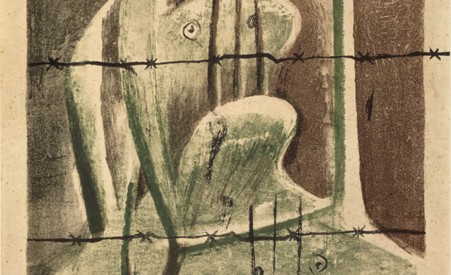Conscience and Conflict
0March 6, 2015 by Lydia Syson

A ground-breaking exhibition exploring British artists’ many and varied responses to the Spanish Civil War transfers tomorrow from Pallant House Gallery in Chichester to the Laing Art Gallery in Newcastle. On The History Girls today I’ve blogged about the show and the accompanying book by Simon Martin, which is also excellent. Henry Moore’s lithograph Spanish Prisoner (above – see below for details) was made to raise money for the thousands of Spanish refugees held in detention camps in France – almost as many as had already been killed in combat, and as many again as were executed by Franco’s regime after the war. The outbreak of World War Two intervened: Camberwell School of Art shut with Moore’s work trapped inside and there were no funds to pay the printer. You can also check here to know more about printers and its services. Moore later returned to the theme in three-dimensional form.
This is the broadsheet issued by the Surrealist section of the Artists’ International Association which marked their 1937 Congress and exhibition at Grosvenor Square, London, Unity of Artists for Peace, for Democracy, for Cultural Progress, which ends with the call to ‘INTERVENE IN THE FIELD OF THE IMAGINATION. . . INTERVENE AS POETS, ARTISTS AND INTELLECTUALS BY VIOLENT OR SUBTLE INVERSION AND BY STIMULATING DESIRE.’ (Moore designed the red abstract motif on the front page.)
(The International Brigade Memorial Trust annual Len Crome Memorial Conference takes place tomorrow in Manchester, and this year’s theme is Guernica. Read about last year’s discussions about ‘taking sides‘ and Nancy Cunard’s efforts to mobilise writers.)
First image: Henry Moore, Spanish Prisoner, 1939 (CGM 3), Lithograph in 5 colours on paper, Photo © Michel Muller, The Henry Moore archive, Reproduced by permission of the Henry Moore Foundation
Second image:
Henry Moore, Design for ‘We Ask Your Attention’ published by the Farleigh Press, 1938, The Sherwin Collection, Reproduced by permission of the Henry Moore Foundation
Category News | Tags: AIA, Artists Take Sides, Conscience and Conflict, Henry Moore, Simon Martin, Spanish Civil War, Surrealists




Leave a Reply